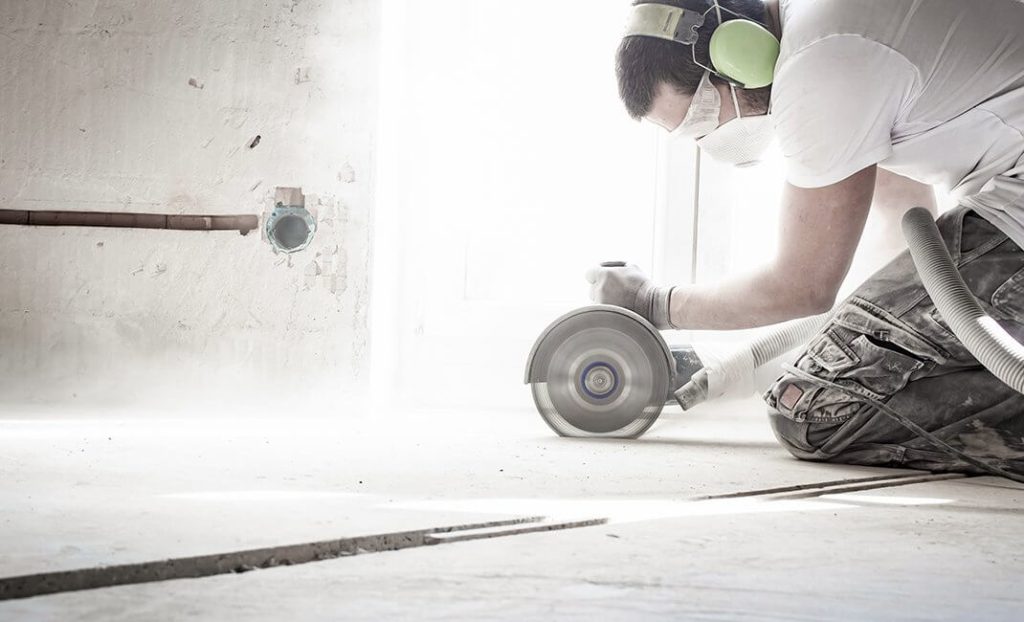OSHA released their final rule on the occupational exposure to respirable crystalline silica in March of 2016. This final rule impacts a wide variety of employers who have employees with exposure to respirable crystalline silica. Vest receives ongoing questions regarding the silica standard requirements for different industries. Below you will find additional clarification on respirable crystalline silica exposure and how it may apply to your business.
What is respirable crystalline silica?
Crystalline silica is a common mineral that is found in many different materials which employees may be exposed to in the workplace. This includes, but is not limited to, stone, artificial stone, granite, concrete, mortar, and sand. Employees can be exposed to respirable crystalline silica dust when cutting, grinding, drilling, or completing other work tasks on silica containing products. In these situations, employees can be exposed to small silica particles which can be inhaled if no protection is provided. If a worker inhales these respirable dust particles, they can become caught in the workers’ lungs and cause silicosis. Respirable crystalline silica also may cause lung cancer, chronic obstructive pulmonary disease, and kidney disease as a result of prolonged exposure. In most cases, these diseases do not occur immediately but occur after years of exposure to respirable crystalline silica.
How are workers exposed to crystalline silica?
Workers can be exposed to respirable crystalline silica during many different job tasks and each job task should be evaluated independently for all hazards. Here are a few of the higher risk job tasks which may expose employees to respirable crystalline silica in General Industry and Construction.
General Industry
- Manufacture of glass, pottery, ceramic, brick, concrete, asphalt roofing, jewelry, artificial stone, dental, porcelain, or structural clay products
- Use of industrial sand in operations such as foundry work and hydraulic fracturing
- Use of sand for abrasive blasting
Construction
- Using masonry saws, grinders, drills, jackhammers and handheld powered chipping tools
- Operating vehicle mounted drilling rigs
- Milling
- Operating crushing machines
- Using heavy equipment for demolition or certain other tasks
- During abrasive blasting and tunneling operations
How would you, as the employer, evaluate your employees exposure to respirable crystalline silica?
The most common and objective way to assess an employees exposure would be to utilize the services of a Certified Industrial Hygienist (CIH) to conduct air monitoring of the breathing zone of potentially affected employees. The CIH is qualified to collect samples, have them analyzed, and create a report of the results.
What if my employees are exposed to silica below the Action Level of 25 μg/m3?
You can discontinue monitoring for any employees who may be exposed, given that the potential exposure does not change.
What if my employees are exposed to silica above the Action Level but below the Permissible Exposure Limit of 50 μg/m3?
- Implement any controls possible to reduce employee exposure below the Action Level.
- Repeat monitoring within 6 months of the last monitoring. Any employees exposed to silica above the Action Level must be offered medical surveillance.
What if my employees are exposed to silica above the Permissible Exposure Limit of 50 μg/m3?
Implement any controls possible to reduce the employees exposure below the PEL and Action Level and offer employees medical surveillance until below the Action Level.
What other requirements do I have if my employees are exposed at or above the Action Level?
- Establish and implement a written exposure control plan that identifies tasks that involve exposure and methods used to protect workers, including procedures to restrict access to work areas where high exposures may occur and designation of competent person to implement the control plan
- Implement any controls possible to reduce employee exposure below the Action Level
- Provide respirators to workers when dust controls and safer work methods cannot limit exposures to the PEL
- Restrict housekeeping practices that expose workers to silica, such as use of compressed air without a ventilation system to capture dust and dry sweeping, using safe alternatives when available
- Offer medical exams (surveillance)—including chest X-rays and pulmonary function tests—every three years to workers exposed at or above the action level for 30 or more days per year, regardless of the usage of PPE
- Train workers on the health effects of silica exposure, workplace tasks that can expose them to silica, and ways to limit exposure
- Keep records of workers’ silica exposure and medical exams
Are my employees required to participate in medical surveillance activities?
- If employee exposure monitoring identifies job tasks which expose employees at or above the Action Level, these employees must be offered medical surveillance if they will be exposed to these job tasks at least 30 days out of the year.
- This medical surveillance includes, but is not limited to, chest x-rays, pulmonary function tests, and physical examinations with special emphasis on the respiratory system. These must be provided at no cost to the employee.
- Employees may refuse the initial and any subsequent medical exams if they so choose. If an employee refuses but changes their mind, the employer must provide the medical examination through a PLHCP for the employee.
How can I protect my employees?
There are many ways that you can protect your employees. Each employee may be exposed differently so it is important that a Job Hazard Analysis is performed on each job task to understand the exposure and potential controls. Below are some examples of proper controls which can be put into place to reduce respirable crystalline silica dust exposure.
- Wet Methods – John Smith Construction Company performs concrete cutting with a walk behind saw. This process should be completed outside with an integrated water delivery system which continuously feeds water to the blade. Respiratory protection may be necessary if this must be performed inside.
- Ventilation and Isolation – ABC Manufacturing prepares large metal parts for painting by utilizing a sand based abrasive blasting process. This process is performed by utilizing a conveyor system which isolates workers from flying debris but fugitive dust still escapes from the equipment. The equipment is outfitted with local exhaust ventilation which removes the fugitive dust to an exterior baghouse, eliminating employee exposure.
- If the respirable crystalline silica dust exposure cannot be reduced below the permissible exposure limit (PEL) using the controls above, only then may the employer use Personal Protective Equipment such as respiratory protection.
What is Table 1 in the Construction Standard?
Table 1 of the Construction Standard provides a static list of 18 common construction tasks which have effective dust control methods available. Employers who perform only the tasks listed in Table 1 which expose employees to respirable crystalline silica dust AND follow the requirements for controls and respiratory protection, may be in compliance with the standard without the need for employee exposure monitoring.
Employers in General Industry may also follow Table 1 guidelines if the task which employees complete meets the following criteria:
- The task is indistinguishable from the Construction task outlined in Table 1.
- The task will not be performed regularly in the same environment and conditions.
All information included in the OSHA Table 1 can be found here.
Respiratory Protection
Respiratory protection may still be required in many circumstances where exposure to respirable crystalline silica dust cannot be fully controlled. Table 1 outlines multiple situations which still require the use of a respirator with an Assigned Protection Factor of at least 10. Usage of Table 1 or other control methods does not exempt the employer from the other requirements of OSHA’s Respiratory Protection program.
All employers who must implement a respiratory protection program, must meet the minimum requirements of the Respiratory Protection standard.
Conclusion
To ensure that your business is in compliance with these OSHA regulations, the first step is to evaluate if you have an occupational exposure to respirable crystalline silica. A Certified Industrial Hygienist (CIH) can assist you with objectively determining if your employees have an exposure over the permissible exposure level. The American Industrial Hygiene Association (AIHA) Consultants Listing is a helpful resource for finding a CIH who can assist. Vest can also assist with completion of the Medical Evaluation Questionnaire and Pulmonary Function Test questions which may arise.
Additional Resources: OSHA has put together additional information which can be found on the OSHA website following the links below.
Silica Frequently Asked Questions
General Industry Outreach Materials



